Climate change
THE DOMINANT cultures of North America have long struggled to take responsibility for the suffering and injustice inflicted upon the Indigenous Peoples of the continent. The archetypal “us/them” story of cowboys and Indians remains at the core of North American national identities, from derogatory sports mascots and symbols such as the Washington “Redskins” and the “Chief Wahoo” character of the Cleveland Indians to the ignorant “redfacing” by non-Indigenous partygoers and trick-or-treaters in contrived Indian outfits. And this situation is nowhere near ending, despite many years of cultural sensitivity training and education.
Such overt racism should never be acceptable today. Yet it persists in regard to Indigenous Peoples. Why is this? As one friend remarked to me, most modern-day Americans believe injustices done to Indigenous Peoples to be a thing of the past.
But are they? Steve Heinrichs, director of Indigenous relations for the Mennonite Church in Canada, has brought together nearly 40 theologians, activists, writers, and poets—half of whom are Indigenous—to create Buffalo Shout, Salmon Cry: Conversations on Creation, Land Justice, and Life Together, a challenging anthology on Indigenous-Christian relations, stolen land, racism, and the impending environmental crisis that we all must face together.
BALLS THUMPED against the walls, jump ropes scraped the asphalt, and shrieks filled the air: The kindergarten and first-grade students of Holy Ghost Catholic School in Albuquerque, N.M., were at recess on a chilly December day. The sun was shining and the kids bumbled around in their jackets, oblivious to the cold. Also oblivious were the rows of leafy greens in the two raised-bed gardens just outside the classroom windows. The sun, plastic covers, and just enough water (which the students figured out after a failed crop or two) made for a perfect little garden oasis in the midst of winter.
Seeing me headed toward the gardens, dozens of children made a beeline for the structures, simultaneously shouting “Miss! Can I see?” “Miss, I’ll water them!” They helped me lift the cover to reveal a jungle of rainbow chard, kale, spinach, salad greens, a few radishes, and basil—a kaleidoscope of greens, golds, pinks, and yellows.
“Miss, can I have chard?” Mateo looked at me hopefully, chubby fingers pointing to the rainbow chard. “Sure!” I exclaimed, gently breaking off a leaf. “If you can name it, you can taste it!” Suddenly there were 15 hands in front of me, along with a litany of names: “The pink one!” “Chard! Chard!” “Can I have that spinach?!”
Not everyone was as enthusiastic. “Yuck,” Lenaia said when I offered her a piece of spinach. “I don’t want to eat it, but I’ll water it.”

In the short three months that I have been at Sojourners as the director of individual giving, I’ve been humbled and inspired by the countless social justice activists who make up our community. In these three months, I have witnessed activism for immigration reform, a vigil for those most affected by congressional dysfunction, organizing for climate change, a prophetic stand for racial justice, the launching of a new campaign to empower women and girls, and much more.

I was raised bilingual and bicultural in New Mexico, the state with the highest percentage of Latino population, nearly 50 percent. In addition to working as an environmental advocate, I am also a member of the rising Latino generation, the fastest growing young demographic in the country. Fifty thousand Latinos turn 18 every month. To put this in perspective, Pew Research Center estimates that by mid-century, Latinos will comprise nearly 30 percent of the U.S. population.
When I was 18, I had just graduated from high school with several years of soccer at Santa Fe’s 7,000-foot elevation under my belt. I was on my way to college, and would go on to complete a master’s of science in an interdisciplinary environmental sciences program.
What my experiences do not include are those that are far too common among Latino 18-year-olds who are disproportionately affected by carbon pollution. Carbon pollution contributes directly to climate change, in turn endangering Latinos due to the resulting health and environmental repercussions. One expected climate impact in the U.S. is more smog in areas with poor air quality, translating to more asthma attacks for our young people. In fact, the Latino community is one of the hardest hit: Hispanic children are nearly two times as likely to be hospitalized for asthma as white children. Other illnesses related to poor air quality, such as chronic bronchitis, are also prevalent within Latino communities, yet nearly half of all Latinos in the U.S. live in counties that often violate ground-level pollution standards.
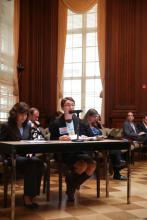
Editor’s Note: This post contains two of many testimonies given at an Environmental Protection Agency (EPA) listening session at EPA headquarters in Washington, D.C. The EPA held sessions in 11 regional offices across the country to allow the public to comment on the agency’s plans to begin regulating carbon dioxide emissions — one of the heat-trapping pollutants that contributes to climate change — from existing coal and natural gas-fired power plants. The public was invited to share up to three minutes of spoken testimony to an EPA panel for the agency’s consideration. We also have multiple other testimonies in parts two and three.
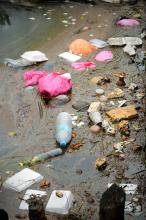
In the Hebrew and Christian scriptures, there is a Psalm that proclaims: “the earth is the Lord’s and everything in it, the world, and all who live in it” (Psalm 24:1). There is no part of this world that God is not aware of, cannot lay claim to, and does not rule. Christians affirm that as people of faith we’re called to be stewards over creation, answering one day for how we’ve treated the earth.
And part of that stewardship means understanding how this world works and what it needs in order to thrive. Unfortunately the din of our political ideologies has too often drowned out the biblical calling to care for creation.
In Texas, the State Board of Education will recommend new textbooks for all its students—and because it has such a large population, what they decide could determine what students in other states learn about science. There are several ideologues submitting textbook critiques to the board and their reviews will factor into each book’s overall score and likelihood of being approved by the school board. These ideologues could block the use of textbooks that teach the reality of climate change for the whole country’s public school students.
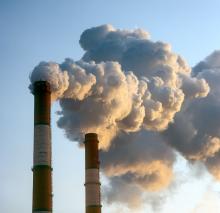
This week the EPA is holding the last few of its listening sessions around the country — 11 in total by the end of the week – to hear what Americans have to say about the EPA’s plans to tackle climate change.
These listening sessions are our chance to give the EPA our comments in person — everyone can register for a three-minute testimony spot — about the agency’s upcoming rule on carbon pollution from existing power plants.
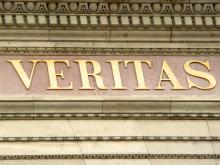
IF YOU WANT to understand why the climate movement missed Tim DeChristopher when he was in jail for two years, you should read the letter he sent recently to the president of Harvard.
Drew Faust—Harvard’s first female president—had just spoken for the establishment (really, the establishment establishment) by publishing a weary, soulless letter explaining that Harvard would not divest from fossil fuels despite the request of 80 percent of its student body. DeChristopher—who was imprisoned for two years after an inspired act of civil disobedience to block a drilling lease auction in his home state of Utah—had just arrived in Cambridge to start at Harvard Divinity School.
“Drew Faust seeks a position of neutrality in a struggle where the powerful only ask that people like her remain neutral,” DeChristopher wrote. “She says that Harvard’s endowment shouldn’t take a political position, and yet it invests in an industry that spends countless millions on corrupting our political system. In a world of corporate personhood, if she doesn’t want that money to be political, she should put it under her mattress. She has clearly forgotten the words of Paolo Freire: ‘Washing one’s hands of the conflict between the powerful and powerless means to side with the powerful, not to remain neutral.’ Or as Howard Zinn put [it] succinctly, ‘You can’t be neutral on a moving train.’”
DeChristopher is exactly right. Just as a tie goes to the runner, so “neutrality” goes to the status quo. And given that we’re in a full-on climate emergency—the Arctic melted last summer, for crying out loud—this kind of neutrality is no more admirable than defending the right of poor and rich alike to sleep beneath bridges.
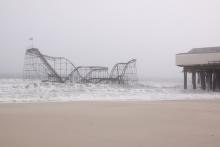
This week marks the one-year anniversary of Hurricane Sandy, the superstorm that decimated metropolitan areas of the East Coast last fall.
Damage from the storm resulted in more than 100 fatalities, with an estimated loss of $65 billion. Thousands of homes were lost, and millions were without power for days. Thousands of flights were canceled along the eastern seaboard, and multiple public transit services were suspended, including Amtrak and New York City’s bus and subway system. Even the U.S. economic structure ground to a halt, with NASDAQ and the New York Stock Exchange closing to buckle down before the deluge.
One year later, we reflect on reconstruction efforts post-Sandy. We also pause to assess the role of climate change, exacerbated by human actions, in the creation and severity of the storm.
Unprecedented levels of air pollution effectively closed the city of Harbin in northern China earlier this week. Smog limited visibility in some places up to 30 feet, and measurements of fine particulate pollution skyrocketed a record 40 times higher than the worse safe level set by the World Health Organization, according to the Washington Post.
In the city of 11 million, schools, public bus routes, and the airport were all forced to suspend activities given the unsafe conditions. Hospital admittances of patients with respiratory problems soared an additional 30 percent.
The cause, according to local Chinese news outlets, was the first day of the city’s heating being turned on before winter. China’s air quality has consistently been found to be harmful in the recent decades of the country’s rapid industrial development.
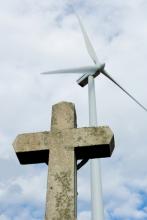
There’s a debate happening on The Christian Post, and we’re hearing more and more evangelical voices expressing concern over climate change.
Over the summer, talk radio pundit Rush Limbaugh made a comment about people believing in God and manmade global warming: he said it was “intellectually impossible.” It is not, of course, impossible to have faith in God and to agree with 97 percent of scientists that we are harming God’s creation with climate change. And in response to Rush’s comments, Sojourners sent Mr. Limbaugh a letter signed by more than 9,000 people of faith asking him to correct the record (which he has not yet done).
But Rush Limbaugh’s comments also sparked a conversation on the popular evangelical website, The Christian Post. Two prominent climate scientists who are also evangelical Christians, Dr. Katharine Hayhoe and Dr. Tom Ackerman, responded to Rush in an open letter on site. They told Rush that, contrary to his assumptions, they are compelled to work in their field by both their faith in God and their expertise in atmospheric science.
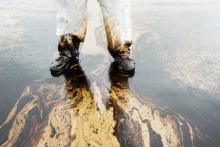
Occurrences of oil spills in several states have garnered little media attention in the last few years. In some cases, prompt reports are recorded, yet in others, days have gone by before the authorities are alerted and the spill becomes public knowledge.
The most recent episode happened Oct. 15, in Port of Long Beach, Calif. Upon discovery of an oil leak, Exxon Mobil announced that it was temporarily suspending operations of its pipeline system. The pipeline, which connects to the company’s refinery in Torrance, carries up to 155,000 barrels of oil per day. Exxon filed documents with the California Emergency Management Agency that claimed the leak did not affect waterways, although the company was ordered to pay a $236 million fine for contaminating groundwater in New Hampshire this past April.
Another spill was initially discovered on Sept. 29 by North Dakota farmer Steve Jensen, the Associated Press reported. While harvesting wheat, Jensen discovered the leak in his field “spewing and bubbling 6 inches high.” The rupture was a break in Tesoro Corporation’s underground pipeline. While it remains unconfirmed, early evidence cites that corrosion on the 20-year-old pipeline is the cause of rupture. At least 20,600 barrels of oil flooded the 7-acre spill zone, equal to about 7 football fields.
The delay in making public North Dakota’s oil spill proves as worrisome as the spill itself. It took 11 days after the spill’s discovery for it to become public knowledge. Officials claim they were not aware how extensive the spill was, but critics point to the state’s financial benefits in the recent gas and oil boom as reason for the authorities’ hesitancy in coming down on oil companies. But economic incentives shouldn’t diminish the serious need to weigh environmental risks and costs.
The cases begin to pile up.

WITH THE HEAT of mid-year finally over—judging by the fact that Dallas has settled into a sweater-friendly 97 degrees—it’s time to look back and see what we’ve learned from another summer filled with unpredictable weather extremes.
For example, a couple weeks in August were actually extremely comfortable, which was no help to my crusade to convince Fox-loving friends that the earth is warming. Lately, even scientists have been of little use, adamantly refusing to blame rampant forest fires and extreme droughts on climate change. They insist on “analyzing” patterns of weather “over time” to honor “standards of science.” There’s nothing worse than climatologists dragging their feet when there are righteous accusations to be flung. Global warming is behind EVERYTHING wrong! You know it. I know it.
Okay, sorry.
But this summer had way too many examples of the extreme consequences of climate change, including deadly tornadoes, inundating floods, and town hall meetings that brought forth a storm of discontent. Unsuspecting members of Congress had left the comforting gridlock of Washington, D.C., and, failing to first check for a full moon, had innocently invited questions from constituents in their home districts. This is almost always a mistake. You really need to test the water before you just walk into a home district unprepared.
OFFICER MARIO normally worked for Homeland Security. On this Friday night he’d been seconded to the Washington, D.C. Metro police, who had their hands full. Not only did they have the usual “drunk and disorderlies,” but now 54 people who looked like card-carrying members of the AARP were filling up their holding cells. Officer Mario, of retirement age himself, was feeling fortunate. He’d been assigned to the women’s side.
“Ladies, ladies, ladies!” Mario said, sauntering in with a mischievous smile. “This must be my lucky night.”
The evening before, we’d all been at St. Stephen and the Incarnation Episcopal Church running role plays on how to “flash mob” the corporate headquarters of Environmental Resources Management (ERM), the firm hired by the U.S. State Department to provide an environmental impact statement on the Keystone XL pipeline. To the disbelief and concern of climate scientists, ERM claimed that TransCanada’s Keystone pipeline would not significantly contribute to climate change. ERM was suspected of “misleading disclosures” regarding conflict of interest and material gain from the pipeline’s completion.
Our white-haired mob of mostly grandparents converged on ERM headquarters at noon to shine a light on such shady dealings. While six silver foxes blocked the elevators by chaining their arms together inside a PVC pipe, I watched two D.C. police lift Steve, age 70, and toss him into the crowd behind me. I knew this nonviolent civil disobedience wasn’t going as planned.

Texas high school biology textbooks battles are once again in progress in Austin, with lines drawn between those who want textbook material based only on established mainstream science and those who are anti-science. As an evangelical Christian and a botany professor at Hardin-Simmons University in Abilene, Texas, I am all too familiar with the battle for scientific authenticity in our state’s textbooks.
The Texas State Board of Education (SBOE) wields an enormous influence over which textbooks are adopted by school districts in Texas. And because the Texas market for public school textbooks is one of the country’s largest, publishers use the curriculum and content from Texas books in those they print for the rest of the nation. For this reason, what happens in Texas doesn’t stay in Texas. This is why it is so important that we ensure that publishers produce books based on mainstream science.

I just completed my first Climate Ride, journeying 300 miles by bicycle over five days with 200 other climate activists. Climate Ride began five years ago, and the riders raise money for organizations that work on sustainability and climate change. They’re also a way to spread the word about the growing and increasingly determined climate movement. For those of us who take part – by now, thousands of us have – the rides have a deep and lasting impact.
These are my reflections from the last day of the ride; you can read reflections on the first four days of the Climate Ride here.

Corporate raider T. Boone Pickens made billions as a Texas oil baron, but he’s betting that the real money will come from mining “blue gold”—water. Pickens owns more water than anyone in the U.S.—he’s already bought up the rights to drain 65 billion gallons a year from the Ogallala Aquifer, which holds the groundwater for much of the Great Plains. Almost all the Ogallala water—95 percent—is used for agriculture, but Pickens plans to pipe it down to Dallas, cashing in on the hotter-and-drier weather from climate change. (The result, according to an Agriculture Department spokesperson: “The Ogallala supply is going to run out and the Plains will become uneconomical to farm.”)
Pickens isn’t alone in his new role as a water baron. Multinationals such as Nestlé are buying up water rights, siphoning lakes, and selling our most precious resource to the highest bidder. Slick advertising has seduced many Americans into the mistaken belief that (expensive) bottled water is “purer” or “healthier” than tap water—and led to the annual consumption of 9.67 billion gallons of bottled water, with underserved Latinos and African Americans having the highest rates of bottled water use. And the Organization for Economic Cooperation and Development warns that by 2030 nearly half of the world’s population will inhabit areas with severe water stress.
As our authors explain, cities and towns across the country are in the midst of an epic fight to keep water as a public trust. Communities of faith have joined what they see as a battle for basic justice: Protecting the right of everyone, rich and poor alike, to the crucial stuff of life, water. —The Editors
THE UNITED STATES has one of the best public water supply systems in the world.
More than 250 million people count on local governments to provide safe drinking water. Over the last 40 years, federal, state, and municipal governments have worked together to improve and protect water resources. The Clean Water Act, the Safe Drinking Water Act, and the Endangered Species Act have kept the U.S. on target for preserving rivers, lakes, watersheds, wetlands, natural aquifers, and other sources of fresh water.
Great strides have been made in managing waste water and storm water. More than 90 percent of community water systems in 2012 met all federal health standards. Public water utilities have been a tremendously successful model for the U.S. and continue to keep drinking water safe, accessible, and affordable for all Americans.
It hasn’t always been this way.
During the 1800s, private companies controlled the water systems of several large U.S. cities—to dire effect. Because the companies were more interested in making a profit than providing good service, many poor residents lacked access to water. As a result, cholera outbreaks were common in poor neighborhoods; water pressure was sometimes too low to stop fires, which destroyed both homes and businesses.
By the turn of the 20th century, city governments, including Baltimore, Boston, New Orleans, and New York City, had taken over drinking water provision from private companies. The goal of government was to improve service, reduce waterborne diseases, and increase water pressure to better fight fires. New York City, for example, assumed control of its drinking water services from the bank and holding company called the Manhattan Company, the predecessor of JPMorgan Chase, after an outbreak of cholera killed 3,500 people and a devastating fire caused extensive property damage.
As the Creation Care campaign associate at Sojourners, my job is to get people thinking about God’s call for us to care about the creation. Usually, I do that from behind a desk in Washington, D.C., but recently I got to do it from a boat out on the bayou in Louisiana, in a tiny community that has been hit by eight disasters in eight years (seven hurricanes and the Deepwater Horizon oil spill). I took 100 people out to the town of Jean Lafitte, less than an hour from New Orleans, to hear from people who live on the front lines of climate change.
One of the obstacles to igniting a passion about climate change is that it feels so abstract; it feels like a future problem, a global problem. But it’s really a here and now problem. We took folks out on the Louisiana bayou to meet with those who are living in the midst of climate change – people who don’t think of themselves as environmentalists, but who can bear witness to the impact that climate change and our use of dirty energy have had on their lives, personally.
The town of Jean Lafitte is an old and diverse town, a close-knit community where faith is important to many people, including the mayor. It’s a town that sounds a lot like the early Christian church. We were told that homelessness is not a problem there – if your neighbor loses her home, why wouldn’t you take her in? We were told that when the state government showed up two weeks after Hurricane Katrina, the town had recovered so quickly that the government thought the hurricane hadn’t hit them. This community comes together, and because it knows how to survive, it often gets forgotten by government responders and by oil companies like BP.

I always thought of climate change as something that affected developing countries. Through my work at World Renew, an international disaster response and community development organization, I am well acquainted with the devastating effects of changing growing seasons in Africa and environmental refugees in Bangladesh. I probably shouldn’t have been so surprised to learn that there are ecojustice issues here in the U.S. — but I was.
Last week I had the opportunity to tour the town of Jean Lafitte just outside New Orleans. Hosted by Sojourners, it was one of the “Go and See” options during the Christian Community Development Association conference.
Our tour began with a presentation by the Rev. Kristina Peterson and Mayor Tim Kerner at the Jean Lafitte National Historical Park and Preserve. There we learned that since the 1930s, Louisiana has lost a football field of wetlands every 38 minutes. At the current rate, the state will lose an area of wetlands the size of Rhode Island by 2050. According to Peterson, 36 percent of the wetland loss can be attributed to the activities of the oil and gas industry — in particular, the canals they carve out.

In my state of Minnesota, there are literally hundreds of faith-based green teams doing a variety of good works. We’ve collectively tackled solar panels and bike racks. We’ve individually been consuming less, doing energy audits of our homes, and taking action in our neighborhoods. It is important work. And yet when I talk to the lay leaders in these congregations, they report that enthusiasm has waned and that their groups have become stale. As one tired (and yet tireless) leader confided in me: “I don’t know what it is, Julia, but it’s like we are swimming in molasses.”
As the new executive director of Minnesota Interfaith Power & Light I am trying to pay attention. What is this feeling of stuck-ness? If it’s not working, what then is the special sauce that will help these tireless leaders to ignite their communities?
A few observations about humans: